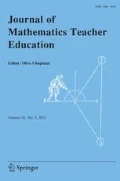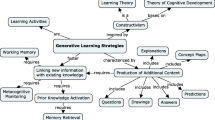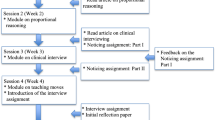Abstract
We report on interview results from a classroom teaching experiment in a Number and Operations course for prospective elementary teachers. Improving the number sense of this population is an important goal for mathematics teacher education, and researchers have found this goal to be difficult to accomplish. In earlier work, we devised a local instruction theory for the development of number sense, which focused on whole-number mental computation. In this study, the local instruction theory was applied to the rational-number domain, with the help of a framework for reasoning about fraction magnitude, and it guided instruction in the content course. We interviewed seven participants pre- and post-instruction, and we found that their reasoning on fraction comparison tasks improved. The participants made more correct comparisons, reasoned more flexibly, and came to favor less conventional and more sophisticated strategies. These improvements in number sense parallel those that we found previously in mental computation. In addition to the overall results, we highlight two cases of improvement that illustrate ways in which prospective elementary teachers’ reasoning about fraction magnitude can change.


Similar content being viewed by others
Notes
We acknowledge that finding a common denominator can be a useful approach to fraction comparison tasks. We further acknowledge that this procedure can be performed with conceptual understanding and can work hand in hand with reasoning about fraction magnitude. However, we find that this procedure is widely used but rarely understood.
Smith’s (1995) original framework is based on the reasoning of K-12 students.
References
Australian Education Council. (1991). A national statement on mathematics for Australian schools: A joint project of the states, territories and the commonwealth of Australia/initiated by the Australian Education Council. Curriculum Corporation for the Australian Education Council.
Ball, D. L. (1990). The mathematical understandings that prospective teachers bring to teacher education. The Elementary School Journal, 90, 449–466.
Ball, D. L., Thames, M. H., & Phelps, G. (2008). Content knowledge for teaching: What makes it special? Journal of Teacher Education, 59, 389–407.
Behr, M. J., Wachsmuth, I., Post, T. R., & Lesh, R. (1984). Order and equivalence of rational numbers: A clinical teaching experiment. Journal for Research in Mathematics Education, 15, 323–341.
Carraher, T. N., Carraher, D. W., & Schliemann, A. D. (1987). Written and oral mathematics. Journal for Research in Mathematics Education, 18, 83–97.
Cobb, P., Confrey, J., diSessa, A., Lehrer, R., & Schauble, R. (2003). Design experiments in educational research. Educational Researcher, 32, 9–13.
Conference Board of Mathematical Sciences (CBMS). (2012). The mathematical education of teachers II. Washington, DC: Mathematical Association of America.
DfEE. (1999). The national curriculum handbook for primary teachers in England. London: Department for Education and Employment.
Gravemeijer, K. (1999). How emergent models may foster the constitution of formal mathematics. Mathematical Thinking and Learning, 1, 155–177.
Gravemeijer, K. (2004). Local instruction theories as a means of support for teachers in reform mathematics education. Mathematical Thinking and Learning, 6, 105–128.
Greeno, J. (1991). Number sense as situated knowing in a conceptual domain. Journal for Research in Mathematics Education, 22, 170–218.
Heirdsfield, A. M., & Cooper, T. J. (2002). Flexibility and inflexibility in accurate mental addition and subtraction: Two case studies. Journal of Mathematical Behavior, 21, 57–74.
Heirdsfield, A. M., & Cooper, T. J. (2004). Factors affecting the process of proficient mental addition and subtraction: Case studies of flexible and inflexible computers. Journal of Mathematical Behavior, 23, 443–463.
Hope, J. A., & Sherrill, J. M. (1987). Characteristics of unskilled and skilled mental calculators. Journal for Research in Mathematics Education, 18, 98–111.
Hsu, C. Y., Yang, D. C., & Li, F. M. (2001). The design of the fifth and sixth grade number sense rating scale. Chinese Journal of Science Education (TW), 9, 351–374.
Japanese Ministry of Education. (1989). Curriculum of mathematics for the elementary school. Tokyo: Printing Bureau.
Ma, L. (1999). Knowing and teaching elementary mathematics: Teachers’ understanding of fundamental mathematics in China and the United States. New Jersey: Erlbaum.
Markovits, Z., & Sowder, J. (1994). Developing number sense: An intervention study in grade 7. Journal for Research in Mathematics Education, 25, 4–29.
McIntosh, A., Reys, B. J., & Reys, R. E. (1992). A proposed framework for examining basic number sense. For the Learning of Mathematics, 12(3), 2–8., 44.
National Center for Education Statistics. (2014). National Assessment of Educational Progress (NAEP) Mathematics. Retrieved from http://nces.ed.gov/nationsreportcard/itmrlsx/search.aspx?subject=mathematics
National Council of Teachers of Mathematics. (2000). Principles and standards for school mathematics. Reston, VA: National Council of Teachers of Mathematics.
National Governor’s Association and the Council of Chief State School Officers. (2010). Common core state standards for mathematics (CCSSM). Washington, DC: National Governor’s Association and the Council of Chief State School Officers.
National Mathematics Advisory Panel. (2008). Foundations for success: The final report of the National Mathematics Advisory Panel. Washington, DC: National Academies Press.
National Research Council. (2001). Adding it up: Helping children learn mathematics. In J. Kilpatrick, J. Swafford, & B. Findel (Eds.), Mathematics Learning Study Committee, Center for Education, Division of Behavioral and Social Sciences and Education. Washington, DC: National Academy Press.
Newton, K. J. (2008). An extensive analysis of preservice elementary teachers’ knowledge of fractions. American Educational Research Journal, 45, 1080–1110.
Nickerson, S. D., & Whitacre, I. M. (2010). A local instruction theory for the development of number sense. Mathematical Thinking and Learning, 12, 227–252.
Parker, M., & Leinhardt, G. (1995). Percent: A privileged proportion. Review of Educational Research, 65, 421–481.
Philipp, R. A. (2008). Motivating prospective elementary school teachers to learn mathematics by focusing upon children’s mathematical thinking. Issues in Teacher Education, 17(2), 7–26.
Reys, R. E., Reys, B. J., McIntosh, A., Emanuelsson, G., Johansson, B., & Yang, D. C. (1999). Assessing number sense of students in Australia, Sweden, Taiwan and the United States. School Science and Mathematics, 99(2), 61–70.
Reys, R. E., Reys, B. J., Nohda, N., & Emori, H. (1995). Mental computation performance and strategy use of Japanese students in Grades 2, 4, 6, and 8. Journal for Research in Mathematics Education, 26, 304–326.
Reys, R., Rybolt, J., Bestgen, B., & Wyatt, J. (1982). Processes used by good computational estimators. Journal for Research in Mathematics Education, 13, 183–201.
Reys, R. E., & Yang, D. C. (1998). Relationship between computational performance and number sense among sixth- and eighth-grade students in Taiwan. Journal for Research in Mathematics Education, 29, 225–237.
Siegler, R., Carpenter, T., Fennell, F., Geary, D., Lewis, J., Okamoto, Y., … Wray, J. (2010). Developing effective fractions instruction for kindergarten through 8th grade: A practice guide (NCEE #2010-4039). Washington, DC: National Center for Education Evaluation and Regional Assistance, Institute for Education Sciences, U.S. Department of Education. Retrieved from http://ies.ed.gov/ncee/wwc/pdf/practice_guides/fractions_pg_093010.pdf
Simon, M. A. (1995). Reconstructing mathematics pedagogy from a constructivist perspective. Journal for Research in Mathematics Education, 26, 114–145.
Smith, J. P, I. I. I. (1995). Competent reasoning with rational numbers. Cognition and Instruction, 13, 3–50.
Smith, J., & Thompson, P. W. (2007). Quantitative reasoning and the development of algebraic reasoning. In J. J. Kaput, D. W. Carraher, & M. L. Blanton (Eds.), Algebra in the early grades (pp. 95–132). New York: Erlbaum.
Sowder, J. (1992). Estimation and number sense. In D. A. Grouws (Ed.), Handbook of research on mathematics teaching and learning (pp. 371–389). New York: Macmillan.
Tsao, Y.-L. (2005). The number sense of preservice elementary teachers. College Student Journal, 39, 647–679.
Tzur, R. (1999). An integrated study of children’s construction of improper fractions and the teacher’s role in promoting that learning. Journal for Research in Mathematics Education, 30, 390–416.
Whitacre, I. M. (2007). Preservice teachers’ number sensible mental computation strategies. In Proceedings of the Tenth Special Interest Group of the Mathematical Association of America on research in undergraduate mathematics education. San Diego, CA. Retrieved from http://sigmaa.maa.org/rume/crume2007/papers/whitacre.pdf
Whitacre, I. M., & Nickerson, S. D. (2006). Pedagogy that makes (number) sense: A classroom teaching experiment around mental math. In S. Alatorre, J. L. Cortina, M. Sáiz, & A. Méndez (Eds.), Proceedings of the twenty-eighth annual meeting of the North American chapter of the International Group for the psychology of mathematics education (pp. 736–743). Mérida, México: Universidad Pedagógica Nacional.
Yang, D. C. (2003). Teaching and learning number sense: An intervention study of fifth grade students in Taiwan. International Journal of Science and Mathematics Education, 1, 115–134.
Yang, D. C. (2007). Investigating the strategies used by preservice teachers in Taiwan when responding to number sense questions. School Science and Mathematics, 107, 293–301.
Yang, D. C., Reys, R. E., & Reys, B. J. (2009). Number sense strategies used by pre-service teachers in Taiwan. International Journal of Science and Mathematics Education, 7, 383–403.
Author information
Authors and Affiliations
Corresponding author
Appendix: Fraction comparison strategies
This scheme is a revised version of that of Smith (1995, pp. 45–47). In the presentation here, we organize fraction comparison strategies by perspective, and we order the perspectives in accord with the hypothetical learning trajectory: Transform, Parts, Reference Point, and Components. Note that this ordering applies broadly on the level of the perspectives. Naturally, the emergence of particular strategies does not follow a strict ordering.
Appendix: Fraction comparison strategies
Transform perspective
In general, we code strategies as Transform when one or both fractions are converted to an alternate form and the student’s activity/explanation appears to be procedural, as opposed to being grounded in a Parts interpretation.
Reduce to Lower Terms. The student compares the two fractions by first reducing one or both of them to lower terms. If the transformation results in the fractions being identical, the student concludes that they are equal. If the two fractions reduce to different fractions, the student compares these by some other strategy, such as the Numerator Principle.
Raise to Higher Terms. The student compares the two fractions by first raising one or both of them to higher terms. If the transformation results in the fractions being identical, the student concludes that they are equal. If the transformation results in different fractions, the student compares these by some other strategy, such as the Denominator Principle.
Convert to Common Denominator. The student compares two fractions by transforming one or both so that they have a common denominator. The student may then employ the Numerator Principle or some other strategy to make the comparison.
Convert to Common Numerator. The student compares two fractions by transforming one or both so that they have a common numerator. The student then employs the Denominator Principle to make the comparison. If the student applies a Parts interpretation, the perspective should be coded as Parts.
Cross Multiply. The student compares two fractions by first multiplying the numerator of each fraction by the denominator of the other fraction. If these products are equal, the student concludes that the fractions are equal. If the products are not equal, the student selects the fraction whose numerator was a factor in the greater product as the larger of the two fractions.
Convert to Decimals. The student compares two fractions by converting them to decimal form. The conversion may be accomplished by long division, recall, or some other method. The student then compares the decimal numbers to determine which of the given fractions is greater.
Convert from Improper to Mixed. The student compares two improper fractions by first transforming both of them to mixed numbers. The student then employs a different strategy to compare the remaining fractional parts of the two mixed numbers (In our data, mixed numbers were between 1 and 2).
Parts perspective
Numerator Principle. Given a comparison in which the denominators are equal, the student selects the fraction with the greater numerator as the larger of the two fractions. The student’s explanation addresses the fact that the denominators are equal and applies a Parts interpretation.
Denominator Principle. Given a comparison in which the numerators are equal, the student selects the fraction with the lesser denominator as the larger of the two fractions. The student’s explanation addresses the fact that the numerators are equal and applies a Parts interpretation.
Compare Complements. The student compares two fractions by comparing their complements and concludes that the fraction with the smaller complement is greater. The student’s explanation makes applies a Parts interpretation and makes explicit the logic that a smaller complement implies a greater fraction.
Denominator Dominance. Given a comparison in which neither the numerators nor the denominators are equal, the student selects the fraction with the lesser denominator as the larger of the two fractions. The student’s explanation applies a Parts interpretation to the comparison of the denominators but does not account for the fact that the numerators are not equal.
Numerator Dominance. Given a comparison in which neither the numerators nor the denominators are equal, the student selects the fraction with the greater numerator as the larger of the two fractions. The student’s explanation applies a Parts interpretation to the comparison of the numerators but does not account for the denominators being unequal.
Combination. In some cases, students combine the strategies above. For example, a student might compare 7/9 with 6/11 by noting that ninths are larger than elevenths and that seven is more than six, so that 7/9 is greater. This strategy essentially combines the Numerator Principle and the Denominator Principle into a two-part argument. We code such a strategy as Parts Combination and note the particular strategies that were combined.
Reference Point perspective
Straddle. The student compares two fractions by reasoning that one fraction is greater than a benchmark fraction and the other is less than that same benchmark fraction. The student concludes that the fraction that is greater than the benchmark is the greater of the two fractions.
Distance Below. The student compares two fractions by comparing them to a benchmark fraction. In cases where both fractions are less than the benchmark, the fraction that is closer to the benchmark is the larger of the two fractions. A special case of Distance Below occurs when proper fractions are compared to 1. We code this as the Residual Strategy.
Distance Above. The student compares two fractions by comparing them to a benchmark fraction. In cases where both fractions are greater than the benchmark, the fraction that is further from the benchmark is the larger of the two fractions.
Components perspective
Larger Components. The student compares two fractions by choosing the one with larger components as greater (e.g., 5/8 > 2/3 because 5 and 8 are larger numbers than 2 and 3).
Additive Within. Given a pair of proper fractions, the student compares the fractions by comparing the differences between the numerator and denominator in each. The student selects the fraction with the smaller numerator–denominator difference as the greater fraction. If the differences are equal, the student concludes that the fractions are equal.
Additive Between. Given a pair of proper fractions, the student compares the fractions by comparing the differences between the numerators (one numerator minus the other) and the differences between the denominators. If the differences are equal, the student concludes that the fractions are equal (We only saw this strategy employed in the case of a common difference).
Multiplicative Within. The student compares two fractions by comparing the numerator–denominator ratios in each. The student need not explicitly discuss ratios, but necessarily makes multiplicative comparisons between the numerators and denominators. In cases of proper fractions, the student concludes that the fraction with the greater numerator–denominator ratio is greater. If the ratios are equal, the student concludes that the fractions are equal. Multiplicative comparisons involved in this strategy may be exact or approximate.
Multiplicative Between. The student compares two fractions by comparing the numerator–numerator and denominator–denominator ratios. The student need not explicitly discuss ratios but necessarily makes multiplicative comparisons between numerators and between denominators.
Iteration. The student compares two fractions by comparing multiples of them, using the same multiplier for both. For example, 3/16 is compared to 13/60 by multiplying both fractions by 5, which yields 15/16 and 65/60. The student concludes that the fraction that results in a greater product is the greater of the two fractions.
Rights and permissions
About this article
Cite this article
Whitacre, I., Nickerson, S.D. Investigating the improvement of prospective elementary teachers’ number sense in reasoning about fraction magnitude. J Math Teacher Educ 19, 57–77 (2016). https://doi.org/10.1007/s10857-014-9295-2
Published:
Issue Date:
DOI: https://doi.org/10.1007/s10857-014-9295-2




